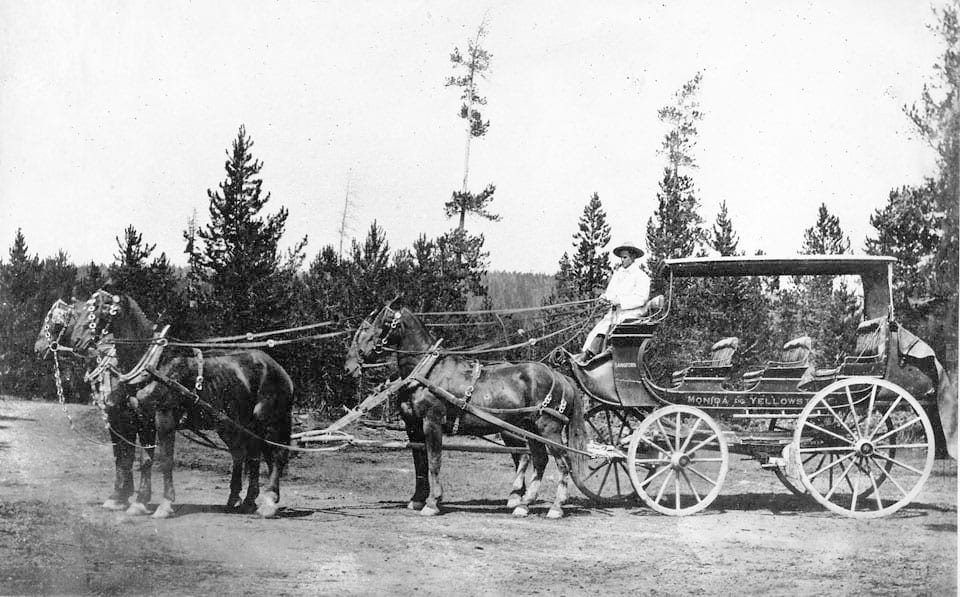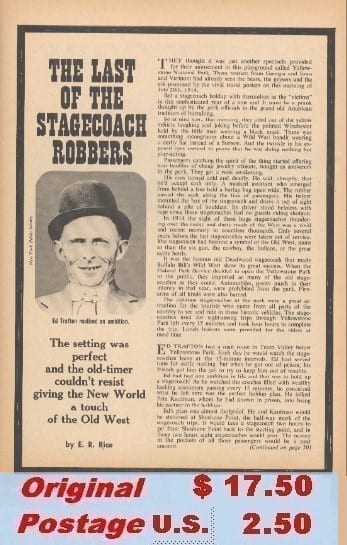The date is July 29, 1914 and you are on a stagecoach trip in Yellowstone National Park. You are not anticipating any problems and your journey has taken you near Shoshone Point which is east of Old Faithful.
There are 25 stagecoaches involved in this journey. Suddenly your group is confronted by gunmen who are intent on robbing all the passengers in the long stagecoach train. They will hold up all twenty-five coaches and will end up making off with nearly $1,000 in jewelry and cash.
However, during the robbery one stagecoach driver is able to turn around and head back to Old Faithful to get help. Fortunately, the robbers do not notice him leaving. One of the passengers manages to sneak a photo of one of the robbers and the following official description of the robber was released by the investigators.
(About 5’8”, weighing about 145 pounds. Blue eyes, short hair, probably dark, with large sunburnt hands. He carried a Winchester rifle and used a black handkerchief as a mask. Dressed in tan corduroy trousers tucked into black, high laced boots, with thick grey socks visible. He wore a felt hat with a hold in it, and an old, faded coat. He spoke good English and was fairly polite.”)
As you might expect, once the description of the robber was released to the public, the law enforcement officials were inundated with tips from a well-meaning public who provided tips to the investigators. One of those tips was that there was a man in town who wore thick grey socks. Yet another told law enforcement to talk to a suspicious new-comer to town who was a male and had dark hair. Some of these tips resulted in several innocent men being arrested.
However, the photo along with witness testimony eventually resulted in the arrest and conviction of a man named Edward B. Trafton.
Another hold up was reported in the Helena Independent. It stated that on the evening of July
4th around 11:00 just as the last coach was traveling from Gardiner to Mammoth Hot Springs it was held up by two highwaymen. The robbery occurred at a point in the trail known as The Eagle’s Nest. The passengers – two gentlemen and three lady tourists – were ordered out of the coach and told to hold up their hands. The highwaymen searched them and got a check for a considerable amount of money and about $16.00 in cash. One of the gentlemen passengers had a purse which contained $800 but he had it in his inside vest pocket so the robbers failed to find it. After they had searched the passengers, one of the robbers held his gun between the heads of the two gentlemen and pulled the trigger. The powder burned the men’s faces and frightened the ladies. The highway men then left and were never identified and were never found.
In all, there were five stagecoach robberies in Yellowstone. The last one occurred in 1914. The one that is considered the greatest stagecoach robbery of the 20th Century happened on August 24, 1908 three miles east of Kepler Cascades. A single robber held up 17 coaches with 174 passengers. He reportedly netted a total of $2,094.20 in cash and jewelry. He was never caught.
In those days, there were no cell phones and the nearest ranger station was miles away so, basically, if you encountered a problem you were “on your own” to handle the situation.
If you are interested in getting additional information about the stagecoaches in Yellowstone you might want to check out the Yellowstone Research Library and the Yellowstone Archives which are located in the Heritage and Research Center located in Gardiner, Montana. In addition, the Yellowstone National Park Museum, located in the HRC has a large collection of stagecoaches as part of their Historical Vehicle Collection. This collection is restricted but there are hopes to eventually build a permanent exhibit. Special tours are possible in you plan well in advance.


